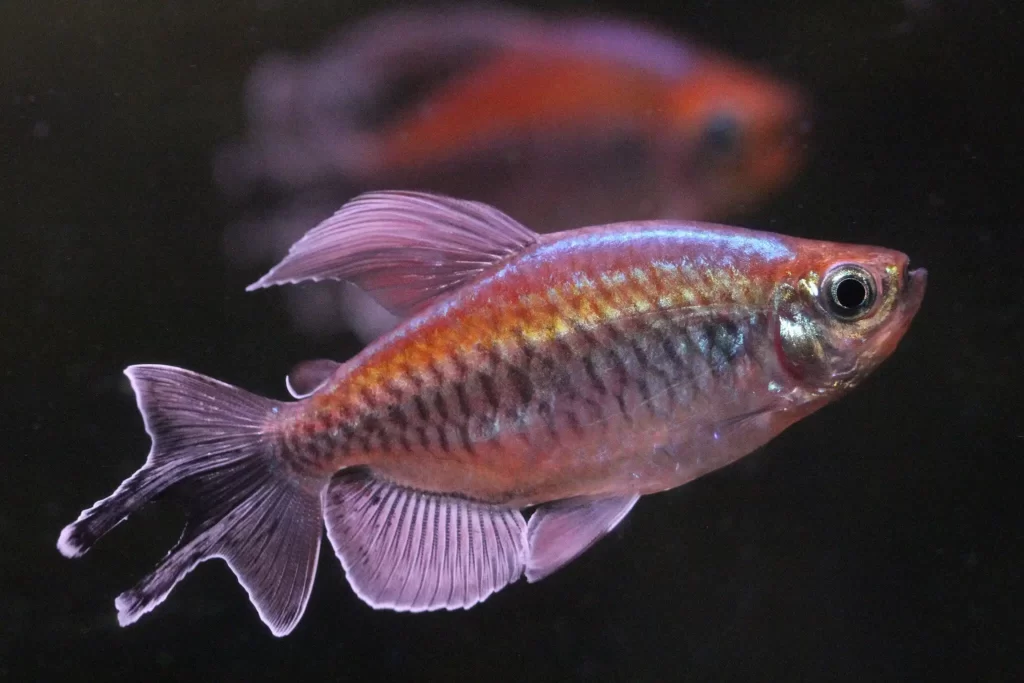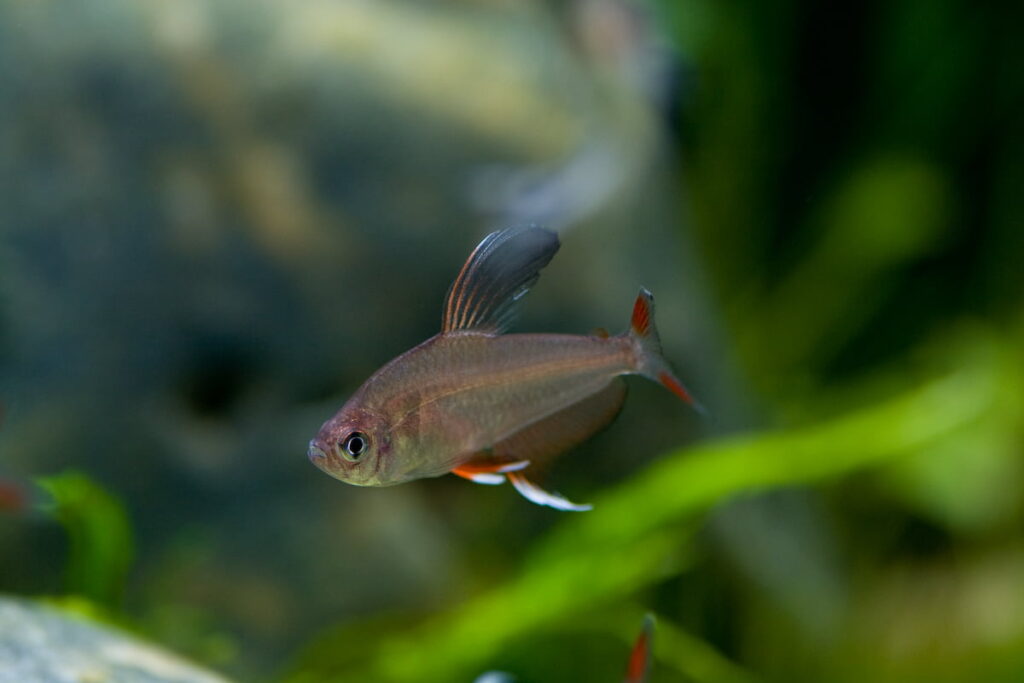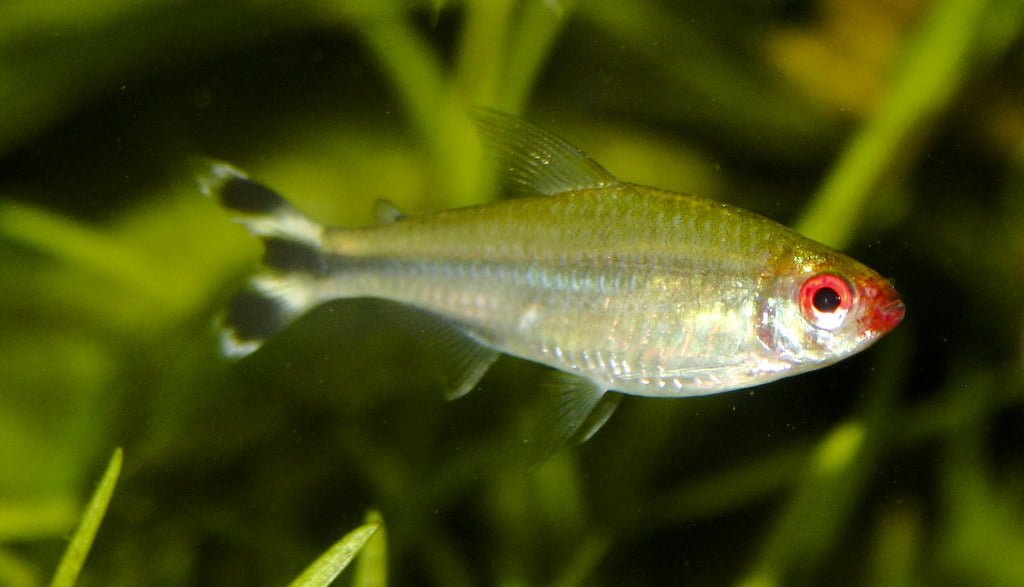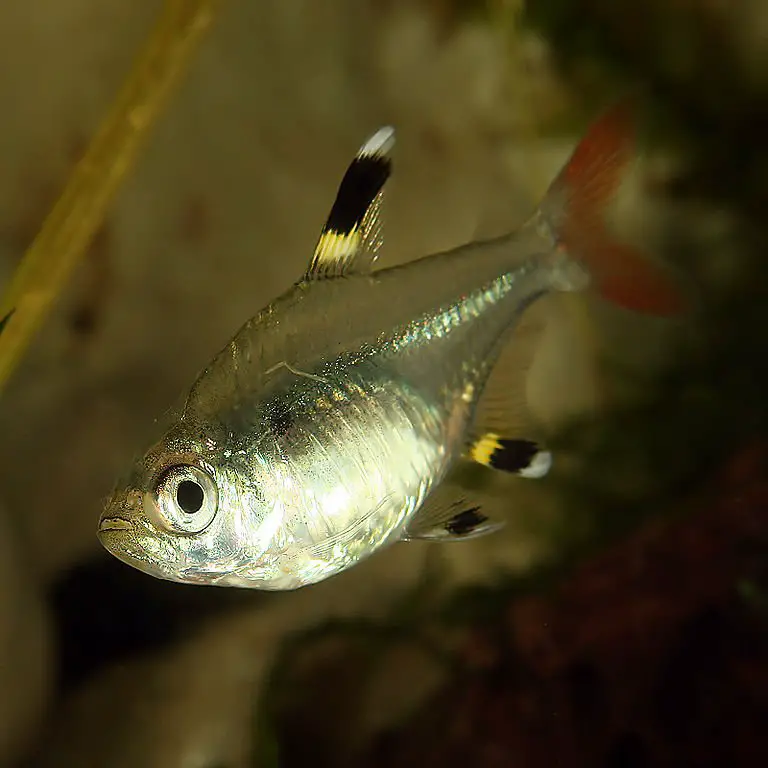Black neon tetras are one of the most common fish you can find in an aquarium shop. They are almost everywhere. Although they are called black neon tetra, they don’t have any resemblance to neon tetra. Sometimes they are called black tetra or neon black tetra; however, black tetra is actually a common name for Gymnocorymbus ternetzi (black skirt tetra).
I personally love black neon tetras because of their nature. They are very friendly and energetic. They always swim in school in a uniform direction, and when they swim in lightly tannin water with a dark background, their beautiful colors will catch anyone’s eye.
Though a minimum of 6 black neon tetra for schooling is acceptable; for the best sight of them swimming; I would recommend buying ten or more.
Introduction of Black Neon Tetra
Black Neon Tetra (Hyphessobrycon herbertaxelrodi) is a peaceful, freshwater schooling fish. They are easy to keep, as they are flexible to many water parameters.
The thing I like about the neon black tetra is that they don’t have high requirements, and a basic setup will go a long way for them.
Therefore, are beginner-friendly fish, so, if anyone is trying to learn to keep schooling fish, this is the one. Likewise, Black tetras are compatible with many other peaceful community fish without worrying.
Classification
Kingdom: Animalia
Phylum: Chordata
Class: Actinopterygii
Order: Characifomes
Family: Characidae
Genus: Hyphessobrycon
Species: H. herbertaxelrodi
Origin and Habitat
Black neon tetras are South America’s freshwater fish. They are native to creeks, tributaries, sandbanks, and flooded forests of the Paraguay Basin of Southern Brazil.
In nature, they live in soft water, which is slightly acidic. As these areas have brackish water, the water is stained brown from chemicals released from organic materials like a dead leaf, driftwoods, and sand.
Description of Black Neon Tetra
Black Neon Tetra are most famous for their color. They have an unusual color (iridescent) and aren’t found in other fish.
The fish have black and shiny white horizontal stripes that extend from the gill area to caudal fins, which include shining green and yellow spots on the white stripe and below the black stripe. It is also grayish in its body.
Their lower caudal fins are colored yellow. But most importantly, they are famous for their eyes. They have an orange semi-circle color lining above their eyes.
The fully grown Black Neon Tetra is larger compared to other tetras. They can grow up to 1.6 inches (4cm).
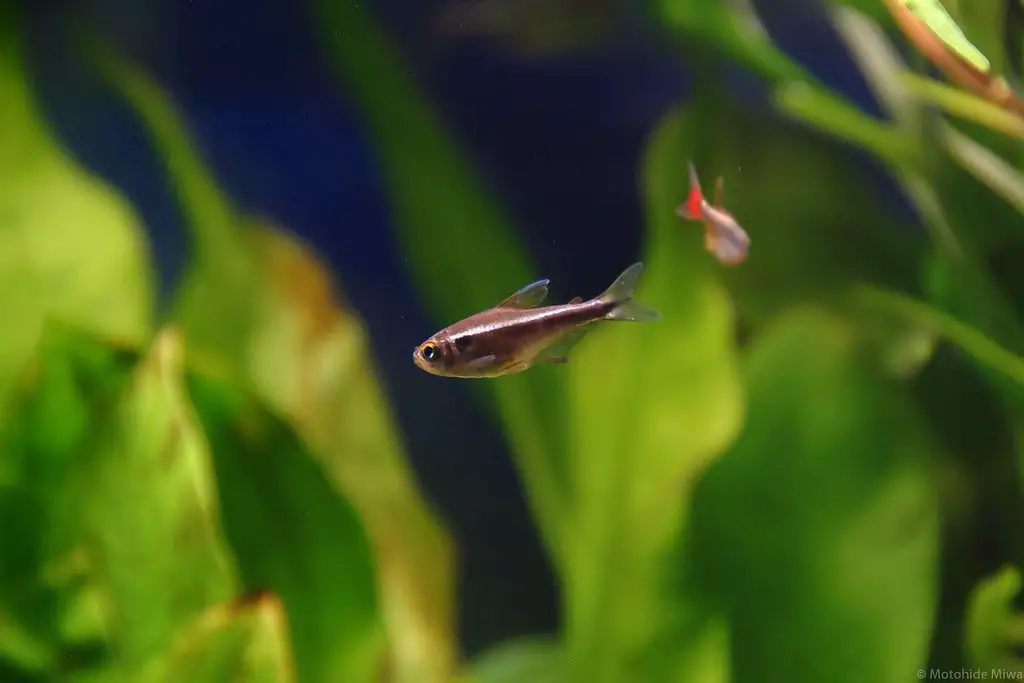
Numbers of Fish
Black neon tetras are schooling fish. A minimum of 10 will be the best. Although other people say 6 of them will work, I found them to be well when at least 10 of them were kept. You can get more if you want, but don’t overstock your tank.
If you get less than 6, black neon tetras tend to show aggression towards each other. This will stress out fish, which may lead to various illnesses.
Lifespan
Black Neon Tetras are very hardy fish and can live for a very long time. In captivity, they can live up to at least 5 years. If proper care is given and good foods are fed, they can live up to 10 years.
Read the following article Black Neon Tetra Lifespan to learn about how you can increase their lifespan in captivity.
Sex Difference
You can differentiate male and female based on their size and body structure. Males tend to be slimmer, and females are more rounded.
You will be able to differentiate their sex during the spawning season. Other than that, only a breeding expert can differentiate their sexuality.
Fish Difficulty
Black neon tetras are hardy fish that can adapt to a wide range of the parameter. Being said that, you need to maintain your water parameter do not let the ecosystem inside your tank disrupt.
These tetras are peaceful, which makes them acceptable to other peaceful community fish. Unlink neon tetras are cardinal tetras, they do hunt shrimps so don’t keep shrimps with black neon tetras.
The only mistake you can do with this fish is by not doing regular water changes or by keeping them less than 6.
Fish Diet
Like any other tetras, black neon tetras are very easy to feed; they eat anything that is given to them. They feed on the top and mid-layer of the tank.
Since they are omnivores, for best health and color, feed them live and frozen food such as bloodworm or live foods such as brine shrimp and Daphnia, along with dried flakes.
They can be fed once or twice a day. Feed the fish as much as they can eat within 1-2 minutes. If you can find it, you can feed mosquito larvae as well.
Proper high-quality food can bring their best color and improve their immunity to fight against diseases.
Aquarium Setup for Black Neon Tetra
Now that you have detail information about the fish, let’s look into how to set up the aquarium for Black Neon Tetra step by step.
Here we will be discussing the tank size, their diet, maintaining temperature, and other factors that you will need to look into in detail when setting up a tank.
Tank Size
Black Neon Tetras are schooling fish. Therefore, they need a large area to swim around. A tank of 2 feet long and 1 foot wide would work if you plan on keeping them in a small number.
I would recommend at least 10 gallons (37.8 liters) if you are going to keep a small number of fish (6). Tank size: the bigger, the better.
If you are planning to create a community tank, then you need to have at least a 75-Gallon tank.
Water Type
Slightly tannin water would be ideal for them. Don’t go, overboard. You can keep them in clear water, but tannin water will bring out their best color.
Filtration
In the wild, they are found in slower streams. To mimic nature, have a slow flow rate filter. A high flow rate can stress them out.
When it comes to water filters, a filter system is your helping hand to maintain your aquarium water chemistry.
All the beneficial bacteria are housed in the filtration media inside your filter. These bacteria help in removing the toxins from your aquarium water.
However, it fails to remove the toxins completely. So, for that, you will have to change at least 10% of aquarium water every week.
If you are confused about which filter you should get, go for a canister filter or a Hang on Back filter.
Penn Plax Cascade 400 Submersible Aquarium Filter is a good choice if you want to go through canister filter.
Decoration
Black neon tetras are not demanding fish. Any sort of decoration can work with them. You can be okay with just plastic decoration.
If you are buying fake plants, make sure to blunt the pointy edges, so they don’t hurt themselves when they swim by.
Always acclimate anything you put into your aquarium; they can carry toxins that can harm the water chemistry, creating a toxic environment for your fish.
You can buy decorations that give plenty of hiding places. When fish are stressed out, they will use that area to hide.
If you are going for tannin water and want to keep a few plants, get java fern, anubias, and amazon sword.
As for the background, get a dark color background.
Substrate
You want to get a substrate that will make the fish even more beautiful. Dark color sand or pebble with a dark background will be the best. It matches the fish body color as well and makes the yellow-green color pop out more.
Lighting
They do well in all sorts of lighting. If you are matching the background, substrate, and tannin water, then go for dim lights.
Water Condition Of The Black Neon Tetra Tank
Black neon tetras in the wild live in soft, slightly acidic, and warmer temperature water. In captivity, they are usually kept in tannin water. Here is what you need to look for regarding your tank water condition.
Temperature
They love a warmer temperature. They thrive in temperatures that range from 73.4°F – 80.6°F (23°C – 27°C). For breeding, 80°F (26.6°C) will be perfect.
pH and Hardness
They love acidic water. They can survive in the range of pH 5-7. I keep them at 6.5.
They thrive in soft water. 2-6 dGH would be great for them.
Maintain the Aquarium Water – Water Change In Black Neon Tetra Tank
Ammonia and nitrite are toxic to fish. Beneficial bacteria in your aquarium convert them to nitrate, which is harmless to fish, but when ammonia is more than bacteria can convert, it will start to harm the fish.
Ammonia is built in your aquarium in two ways; First, when fish produce waste more (overstock compared to tank size) than beneficial bacteria can convert to nitrate, and second when you are overfeeding.
Black neon tetras are hardy fish. You might not need to change the water every week, but I recommend doing it anyway. If you are new to fish keeping, water change weekly will allow you to build a habit and learn more about the nitrogen cycle.
Even though I recommend 50% water change every week, water change depends upon tank size and number of fish in it. If you have a large tank, you can be flexible to do it once every two weeks.
Check water parameters and note them down and find how much water change is necessary for you. Set your own personal routine and continue with it until there are changes in the tank.
I use the API master test kit to test my water parameter once a month to see for changes in ammonia, nitrite, nitrate, and phosphate in my tank.
Black Neon Tetra Tank Mates
Black neon tetras are peaceful schooling fish. You can set a species tank, and they will look as beautiful as you can imagine.
If you are like me and want to see different species of fish living in a community, then they are well suited for it.
Their peaceful behavior allows keepers to keep them with various peaceful community fish: Neon tetra, drape fin barb, ember tetra, cherry barb, guppies, danios, rasboras, etc. You can basically keep anything that is peaceful fish of similar size.
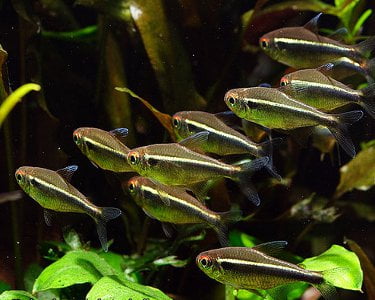
Black neon tetras are top and mid dwellers. For this reason, having a bottom dweller will complete the tank.
Snails and other tank cleaner fish will stay with them. Mystery snail and Cory catfish will eat and clean the remaining food.
Don’t think of them as just cleaners. You also need to take care of them and provide the various food they require.
They may hunt small shrimps.
Don’t keep them with aggressive fish.
Breeding Black Neon Tetra
Black neon tetras are not one of the most natural fish to breed, but if you maintain the right conditions, they will breed.
They are egg layers and will eat the young ones if the parents are not separated. To breed, separate the breeding pair to the breeding tank.
Select the fastest and brightest male and female. It’s better to select females that are over one year old. Get 2-3 males for several females.
Filter and Breeding Tank Condition For Tetra Tank
Though in captivity, they live in various water parameters, for breeding certain parameters need to be maintained.
Breeder tank should be slightly acidic of pH six and hardness of 2-4 dGH at 80°F (26.6°C) temperature. Stock the aquarium with plenty of plants.
You can keep a sponge filter, but I don’t recommend it as fry can be sucked into it. Air Stones would be perfect in the form of circulating water and oxygen.
AQUANEAT 4 is a highly recommended sponge filter for your tetra fry tank as well as breeding tank.
Black Neon Tetra usually spawn in the morning. When female lays hundreds of eggs around the leaves, after breeding, separate the parents as they will eat them.
Eggs and Fry Care Of Black Neon Tetra
After 24-36 hours, the eggs will hatch, and after 4-5 days, you can see the fry. They are tiny and hard to see.
Within moments of the hatch, you don’t need to feed fry as they are still attached to the yolk sac.
After 4-5 days of hatching, feed them Infusoria (ciliates, euglenoids, protozoa, unicellular algae, and small invertebrates).
After a month, try to feed them adult food by breaking them down into smaller pieces. If they reject adult foods, keep on feeding Infusoria until they can eat adult food.
After 8-12 weeks, they will resemble their parents. After nine months, females will be able to lay eggs, but it is better only to allow her to spawn when she is a year older.
Diseases And Cure In Black Neon Tetra
Black neon tetras are hardy fish. Although they don’t get sick as often as other fish, that doesn’t mean they don’t get sick at all.
They do get sick when you keep these tetras in harsh conditions. So, be sure to check your water parameters and tank mates.
If you have all the parameters checked and provide healthy food, you don’t need to worry. However, if you don’t go around doing water changes and providing a nutritional diet, they will get sick.
Always get your fish quarantine tank for 1-2 weeks to see if they are already sick or is carry parasite.
Provide a healthy diet and a weekly 50% water change. If they don’t get sick in this period, they are safe to put in your tank.
If they get sick while they are in quarantine, first identify the problem and start the treatment.
In case your fish get sick when they are in the main tank, first identify the diseases than the source of the problem (it could be because of new fish that you didn’t quarantine, other fish are picking up on the sick fish, bad water parameters or wrong tankmates).
Separate the fish into a small (hospital tank) tank so it will be easier to treat and monitor. If the treatment is going to be on the main tank, remove active carbon.
Summary
Black neon tetras are like a gem in an aquarium. Their iridescent body gives a new color to the aquarium every time. They are hardy fish and can stand to change in water parameters, but like any other fish, you need to provide them the best care as much as possible. Likewise, they live for a long time, and you will never get tired of them.
Keep them in large numbers, and they will live to the fullest. I have always loved them, and I don’t think I will ever get tired of them. Their peaceful nature gives me so much area to work with them. The only thing you cannot do with them is to keep them with shrimp.

